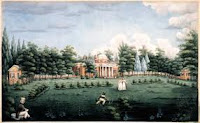Jefferson also championed the western explorations of Meriwether Lewis and William Clark that began in 1803.
 |
| Jefferson's Library at Monticello © LOC.gov |
Jefferson's ideas about individual liberty and intellectual and religious freedom will likely be debated and interpreted through the channels of justice and government for centuries to come. He wrote the statute of religious liberty for Virginia and founded the University of Virginia. The inscription he wrote for his grave at Monticello doesn’t mention it, but Jefferson also served the nation as Ambassador, Vice-President, President and counselor to Presidents. His library formed the nucleus of the Library of Congress.
The third President of the United States described himself as a planter and architect, wrote copious notes on his agricultural experiments collected in the “Garden Book.” The best place to see the man behind the public servant is at Charlottesville and in particular, the home Jefferson designed and built, Monticello.
Jefferson’s practical and tangible achievements - the innovative architectural designs, farming techniques and educatioleal plans - endure and inspire at Charlottesville, a peaceful town east of the Blue Ridge Mountains and Shenandoah National Park, about 70 miles west of Richmond, the capital of the Commonwealth of Virginia
 |
| Watercolor of Monticello in 1827. © LOC.gov |
Named for King George III’s consort Charlotte Sophia, the town was settled in the 1730’s as a tobacco trading center. Despite Jefferson’s then radical theories of democratic government, town sympathies must have tended to the Royalist position and British troops were billeted at Charlottesville during the Revolutionary War.
Jefferson’s beloved Monticello, built on land inherited from his father, demonstrates his dedication to architectural symmetry. Jefferson design for the house and many of its furnishings focus on efficiency - beds are built into walls, placement of windows and doors takes advantage of natural light and prevailing breezes. Hung in the entry hall are artifacts from the western explorations of Meriwether Lewis and William Clark The bookshelves hold beautifully bound editions that replicate Jefferson’s library. His own books were sold to the U.S. government to pay mounting personal debts and formed the nucleus of the Library of Congress.
 |
| Monticello © NPS.gov |
A tour of the plantation is instructive for understanding the need for self-sufficiency and the importance of contributions by the slaves. Though Jefferson wrote that he detested the institution of slavery, he remained a slaveholder. However he improved conditions of his own slaves beyond the standards then accepted in Virginia. Activity on the plantation centered in the dependencies along Mulberry Row where slaves and indentured servants lived and worked in the laundry, dairy, weaving house, carpentry and nail making shops and toiled at all the other crafts necessary to keep the plantation self-sufficient. Jefferson’s extensive vegetable garden and orchards have been magnificently restored over the past fifteen years.


